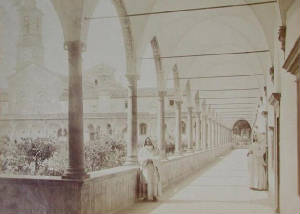|
The Certosa
of the Val d'Ema was founded in 1341 by Niccolò Acciajuolo, Grand Seneschal to Queen Joanna of Naples, and its fortifications
were especially granted by the Republic. Convent-church and buildings were at once begun on a large scale; but the name
of the architect of the Certosa is still unknown. On the 8th of February 1342 the deed of gift was drawn up by which
he endowed the Carthusian monks with all his lands in Val d'Ema. It was located two-and-half miles from Porta Romana, by the
direct road beyond the village of Galuzzo, on the hill of Montaguto, about five km from Florence. The Certosa was suppressed
during the Napoleonic occupation, during which the monastery was sacked and more than 500 artworks disappeared. The cloister
suffered terribly in the earthquake of 1895. In 1896 there were fifteen monks here: the full number was eight-six.


The courtyard has a church dedicated to San Lorenzo, with a Pietra Serena façade. The belfry dates to the 18th century.
The interior is divided into two parts, the first of which now serves as a vestibule. There are several chapels below ground,
including one dedicated to Saint Andrew, in the form of a Greek cross with a vaulted ceiling; it has the tomb of Cardinal
Agnolo II Acciaiuoli.
The monastery proper begins with the Parlour, with a glazed terracotta crucifixion by Giovanni Della Robbia. The large
cloister, a remarkably pure Renaissance construction, has majolica statues by Andrea and Giovanni Della Robbia. The porticos
had frescos by Pontormo that are now in the picture gallery. The second cloister dates to the 1500s, whereas the smaller one
is in Brunelleschian style.


Today, Cistercians from Casamaris inhabit the Certosa, the last Carthusians having fled to Lucca's Charterhouse in WWII,
where monks were killed by the SS. The monastery's books, also, were first taken to Lucca, then to the motherhouse at Grenoble.
The monastery has hosted the Cistercians since 1958.
|
